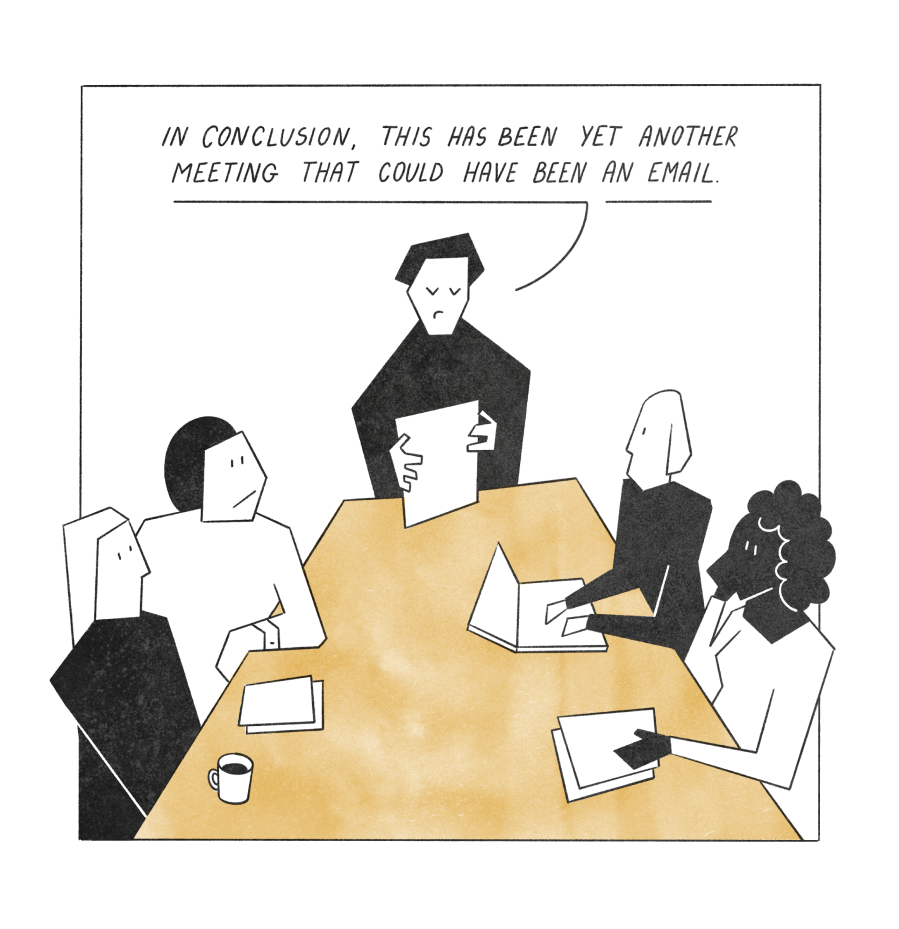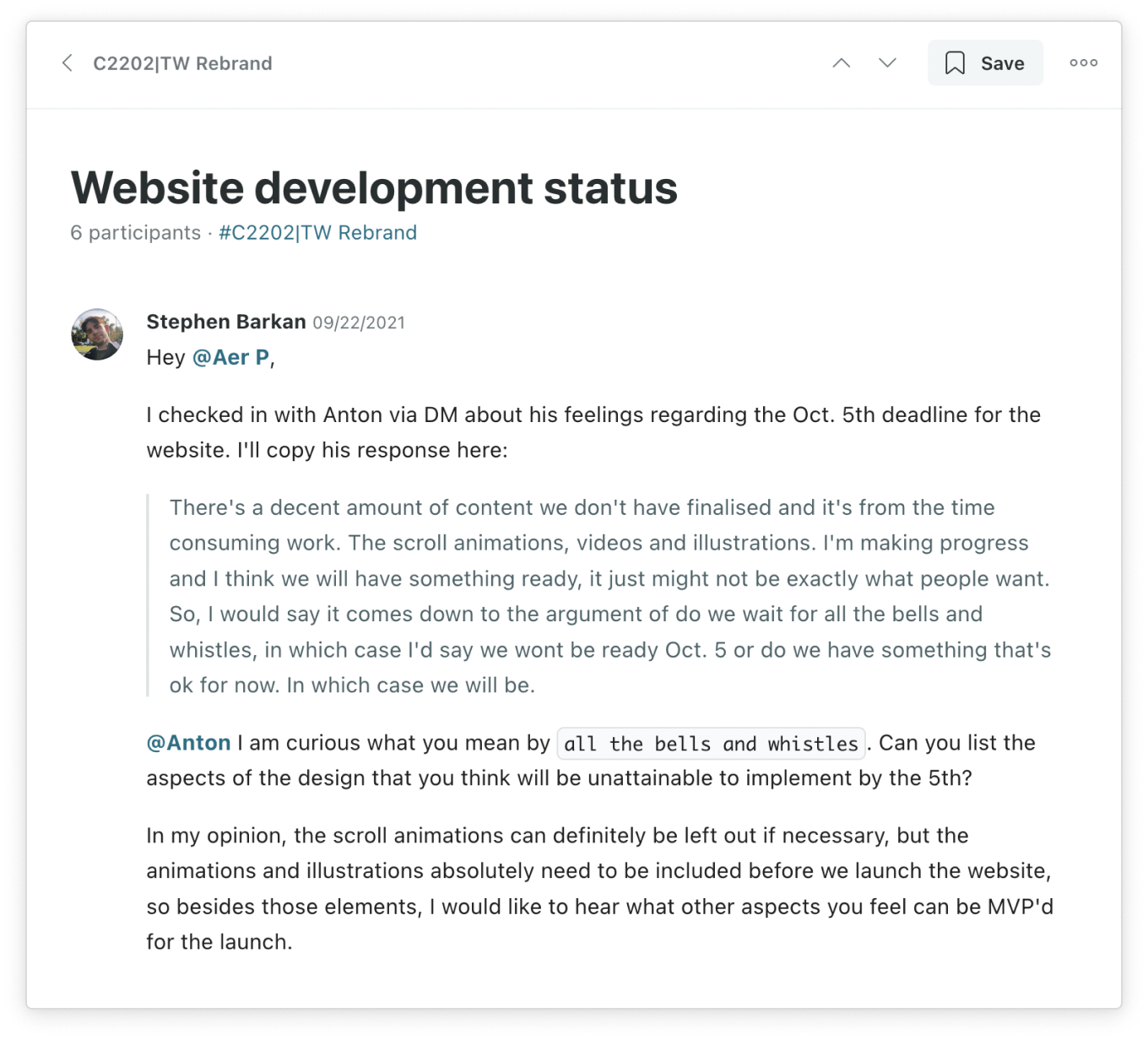The flipped meeting model: a framework for avoiding meeting burnout
By Becky Kane

There’s a common misconception that being an async-first company means you’re anti-meeting. Not true. In fact, I would argue that async-first companies have a greater respect for meetings than most.
The problem arises when meetings become:
- The default for any situation that requires input from someone else
- A time management crutch for leaders too overwhelmed to find time on their own to dig into issues or review work
- A shortcut to avoid clearly thinking through issues and documenting decisions
- A lazy substitute for building team culture and cohesion
- An easy way for insecure managers to feel important and in control
Meetings should be the exception in people’s workdays, not the rule.
The flipped meeting is a framework for reclaiming the meeting as a dynamic tool for collaboration and connection — events your team may actually look forward to — rather than a soul-sucking drain on everyone's time, focus, and energy.
What’s a flipped meeting?
The flipped meeting is a concept adapted from the flipped classroom movement in education. From Michigan State University’s primer on this nontraditional approach to teaching:
In traditional learning, lower level of learning such as remembering and understanding is happening in class, while students are usually left to work on activities that involve higher level of learning outside of the classroom. However, in the flipped classroom model, learning is flipped. As you can see from the pyramid, students can finish the lower level of cognitive work before class. And when they come to class, they can engage in higher cognitive levels of learning with peers and teacher present.
In other words, precious classroom time is reserved for the types of activities that synchronous instruction is best for — actually engaging with the material instead of simply consuming it.
The same principle can be applied to meetings: Synchronous time should be reserved for higher-level collaborating and connecting, not conveying information.
No more company-wide all-hands where a small group of people talk at everyone else.
No more daily standups where everyone takes turns reciting their to-do lists.
A basic rule of thumb: If people can fake paying attention in a Zoom call by looping their video feed or prerecording their participation, that meeting never should have happened in the first place.
The 6 rules of flipped meetings:
- Meeting time should be reserved for meaningful interaction, not conveying information.
- Focus on having fewer meetings first, then figure out how to make the ones you do have better.
- Everyone should come prepared with the information and context to participate. Twist threads, Almanac documents, Loom videos, and Pitch presentation recordings are all great ways to provide context asynchronously before a meeting.
- No one should feel obliged to attend a meeting where their active participation isn’t needed.
- Meetings should be limited to fewer than eight people — the upper limit beyond which meaningful participation falls off and people become more guarded and less candid. Five or fewer is even better.
- Outcomes should always be documented afterward for people who couldn’t or didn’t need to attend.
Using async communication to make the meetings you do have more productive
Like the flipped classroom, flipped meetings require everyone to come prepared with the information they need to participate. Here’s how to use asynchronous communication to get the most out of synchronous time together:
Before a meeting
Don’t just send an agenda with the top level points you want to discuss. Start a thread, document, or digital whiteboard that provides all of the information and context that people need to participate meaningfully in the meeting.

Would it be easier to just call a meeting with a traditional agenda? Absolutely. But the extra effort pays dividends in higher-quality discussions and decision-making.
Writing out the nuances of an issue forces clearer thinking and leaves space for async questions, clarification, and discussion even before everyone gets on a call. Oftentimes, our team finds that an async thread is sufficient for coming to a resolution. No meeting required.
And when a meeting is necessary, everyone comes to the table with a deeper understanding of the issue at hand. We spend that precious time together discussing solutions rather than spending half the meeting just getting everyone up-to-speed.
After a meeting
In the same thread or document you started before the meeting, summarize what the outcome was and why, along with any action items that came out of it. Anyone who wasn’t able or didn’t need to attend the meeting can follow along with what happened on their own time. The decision is then documented and can be referenced and linked to in other relevant conversations.
Async alternatives to “information” meetings
These common “information” meetings are all low-hanging fruit when it comes to winning back time on your team’s calendar for focused work:
Company all-hands → company-wide threads
Instead of company-wide all-hands, our leadership teams posts company-wide threads in Twist that everyone can read on their own time. Those async threads have a life far beyond an hour-long meeting:
- Subsequent discussion happens asynchronously with everyone having an equal opportunity to ask questions and weigh in.
- Those threads can then be referenced and linked back to over and over again in other threads as the company’s high-level priorities tie back to the actual work being done.
- New team members can go back and read them weeks, months, or even years later.

Town halls → async Q&As
Town halls are a great way to build team transparency and cohesion, but they should never require everyone to be on the same call at the same time. We’ve recently experimented with an async AMA with our CEO. We started a thread a week in advance where people could post their questions, then Amir recorded a Loom with answers and posted it to the thread. Again, everyone had an equal chance to participate regardless of time zone and no one had to interrupt their day for a meeting.

Standups & status updates → async snippets
At Doist, each team has a weekly snippets thread where we post our top level priorities for the month, what we did last week, and what we’re focusing on this week. We use a recurring thread template structured around our company values as a way to ensure that we’re focusing on the task with the highest impact, intentionally reflecting on learning and growth, and checking in on anything that’s affecting our well-being.

Similarly, the fully remote team at Remote-how uses a “Daily Progress” thread in Twist as a ritualistic way for team members to check in at the beginning of the day and check out at the end of it. This allows everyone to be aware of their progress, fosters a sense of togetherness even across time zones, and helps teammates put boundaries around the day.
What about the human connection you get from meetings?
Too many leaders assume that “team culture” will automagically happen if everyone is meeting regularly, whether that’s in the office or online.
It won’t.
If the goal of a meeting is social connection then make it about social connection. By turning weekly or daily standups and status updates into async, written snippets, you free up time for the kind of team-building that can’t happen over a thread.
For example, during the pandemic, the marketing team at Doist started doing weekly check-in calls. We usually spend half the time just hanging out and the other half doing red, yellow, green check-ins:
- 🔴 “Red” means you are having trouble focusing, you’re extremely distracted, and/or you’re feeling distressed.
- 🟢 “Green” means you are feeling good, focused, relaxed, and ready for any discussion.
- 🟡 “Yellow” is somewhere in between.
Your color could be about work things or things going on in your personal life you may want people to know. While we inevitably end up talking about the work issues that are top-of-mind, this meeting is fundamentally about connection.
Here are three kinds of recurring meetings that we’ve found to be indispensable to building team cohesion on remote, async-first teams:
- 1:1s between managers and direct reports at a frequency that makes sense for both sides. Usually weekly, every other week, or monthly.
- Monthly casual hangouts/coffee chats. Just be sure these are actually optional. Sometimes people want more social connection, other times they just want to stay heads down in their work. They shouldn’t be penalized for that. Here’s a more in-depth look at how we create opportunities for connection.
- Weekly team check-ins. This isn’t just a regurgitation of what you did and what you’re going to work on next — that can easily be done asynchronously in snippets. Experiment with different formats to find one that works for your team.
Meetings are a powerful tool for remote, async-first teams for collaborating and building connection. They’re also extremely costly in terms of hours lost and focused work interrupted.
The flipped meeting model is simply a reminder to use the precious time together for what you truly cannot do in an email and default to async for everything else.
What’s Twist? Twist is an async messaging app for teams burned out by real-time chat, meetings, and email.
You don’t need to use Twist to get a ton of value out of this newsletter and community. But if the topics we talk about resonate with you, there’s a good chance the app will too. See what makes Twist different →
🌎 Built asynchronously by the fully remote team at Doist
